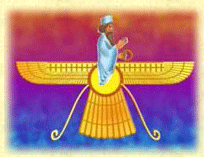 |
Zoroastrianism was founded by Prophet Zoroaster around 800 BC. These Zoroastrians are known as Parsis in India. There are about 100,000 Parsis in India
who are living in Bombay and other places of India. Over various centuries, these Parsis have intermarried among themselves in order to preserve purity of
their blood, thereby creating some problems for their races. This system is now breaking down as many Parsis do not feel the necessity to marry among
themselves. Due to the invasion of the Islamic Arabs in Iran
around 766 AD, these Zoroastrians have to leave Iran. The first Zoroastrians arrived on the West
coast of India in 936 AD as they found safety here. |
|
Until 1477 they lost all contact with Iran, and then for nearly 300 years maintained contact with Persian
Zoroastrianism through a continuous exchange of letters. These Zorastrians were now known as Parsis or Persians.
There has been a prominent economic and social influence of the Parsis, especially in the western part of India. They adopted westernized customs and
dress, and took new economic opportunities that came with colonial industrialization. Various industrialist families like Tata have continued to be among
India's leading industrialists in west India, but now only the recent generations have spread to Europe and North America. |
Origin
Zoroastrians have traced their beliefs to the prophet Zarathustra who lived in North East Iran around 6th or 7th century BC. He enjoyed the patronage of the
father of Darius the Great. The passage of Alexander the Great through Iran severely weakened the support for Zoroastrianism, but between the 6th century
BC and the 7th century AD it was the major religion of people living from North India to central Turkey. The spread of Islam reduced the number of
Zorostrians dramatically and forced those who
did not retreat to the desert to emigrate
altogether.
|
Parsi Beliefs
The holy book of the Zoroastrians is the Zend-Avesta, which describes the battle between good and evil. The Parsis believe in a single God. Their God is
Ahura Mazda, who is symbolized by fire. Ahura Mazda, the Good Religion of God, was shown in rejecting evil and in purifying though word and action. The Parsis worship fire, keeping the symbol of their belief burning in their temples. Fire plays a central and symbolic part in the Zoroastrian worship, and as well
as represent the presence of God. There are eight Atash Bahram, out of which four are in Bombay, two are in Surat and one each in Navsari and Udwada. There are various other minor temples, where the rituals are far less complex. There are about forty temples in Bombay. The Parsis regard the earth, fire
and air as sacred, while death is considred as the result of evil. The Parsis
believe that the sead matter pollutes all it touches. The dead bodies are placed in the open suitable space where they are consumed by vultures, as at the towers of silence in Bombay. Burial and cremation are also common among the
Parsis. |
 |
|

